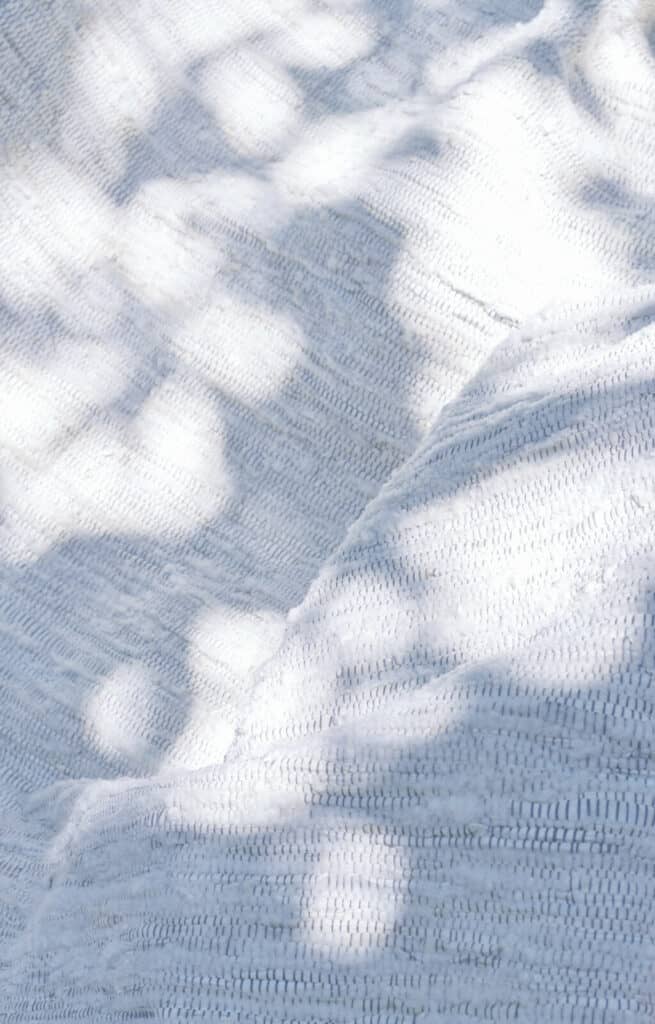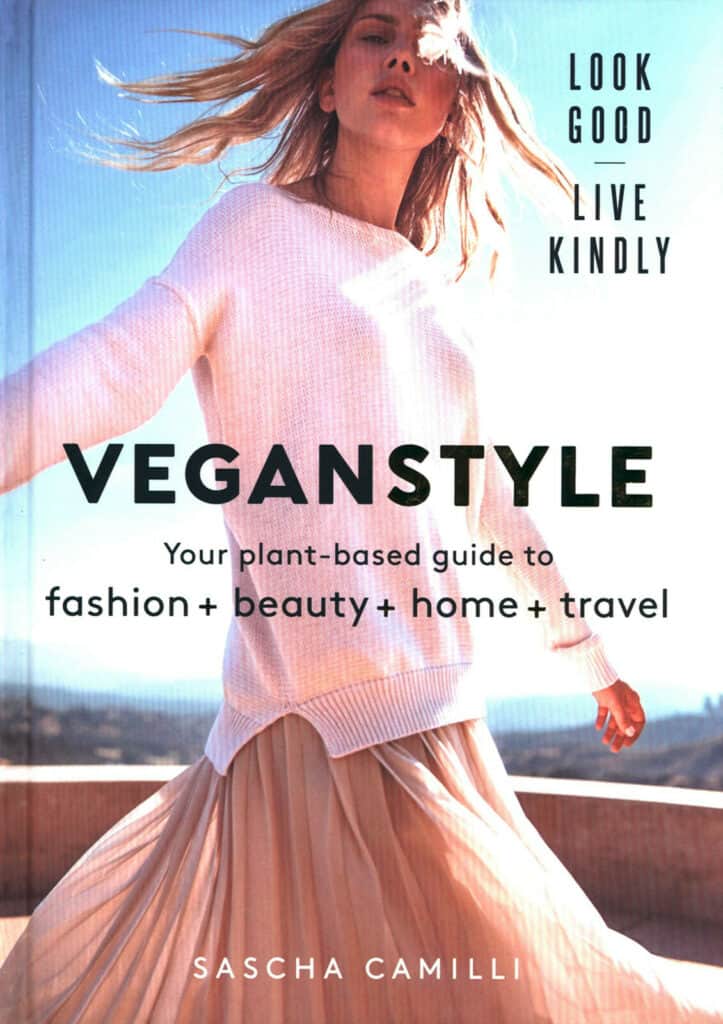Trying to shop vegan but a bit confused about how to read labels (or online descriptions)? Here’s your easy vegan clothing materials cheat sheet!
Vegan clothing materials are made without animal products. These can be plant fibres (cotton, hemp, linen) or plastic-based materials (polyester, polyurethane). Clothing materials that aren’t vegan are extracted from the skin (leather), feathers (down), fur, teeth and bones of a wide variety of animals.
Here’s your quick cheat sheet to spotting vegan clothing materials and avoiding the non-vegan ones!

(Note: this blog post contains affiliate links to products I genuinely like. All products are vegan to the best of my knowledge. If you click a button or a link and make a purchase, I may earn a commission at no cost to you. Thank you for supporting my work!)
Vegan clothing materials
Here’s an overview of some of the main vegan clothing materials and how they’re made:
| Material | Where it comes from | Sustainability |
|---|---|---|
| Acrylic | Formed by free-radical polymerization in an aqueous suspension (no, I don’t know what that means either!) | Washing acrylic garments releases more microplastics per wash than polyester (or polyester-cotton blends). |
| Bamboo | Bamboo fibre | Renewable and can be replenished at a fast rate, generally has a positive impact on the climate and its local environment. |
| Cotton | Fibre that grows around the seeds of the cotton plant | Cotton is a thirsty crop (significantly more than the other plant fibres) and its production often relies on fertilizers, insecticides and herbicides – try to favour organic cotton when possible. |
| Denim | Made from cotton, often with a small amount of an elastic material, e.g. spandex* | Look out for the Global Organic Textile Standard (GOTS) to know that the garment hasn’t been sandblasted. |
| Hemp | Fibre from Cannabis sativa cultivars | Generally considered environmentally friendly. |
| Linen | Fibre from the stem of the flax plant | One of the oldest fabrics, it uses less water than cotton and produces little waste as the whole plant can be used. |
| Plant-based leathers, e.g. Piñatex | Made from apples, grapes, mushrooms, pineapples… | Can sometimes be mixed with plastic, but generally a positive direction of travel given the environmental footprint of leather. Some plant-based leathers use waste products from the pineapple, wine, etc. industries, for instance Minuit Sur Terre shoes. |
| Polyester | Tbh I don’t even understand, but check this out if you want to know more | Most synthetic polyesters (commonly used in clothing) are not biodegradable. They contribute to microplastics pollution of freshwater and seawater habitats when washed. |
| Rayon / viscose / lyocell | Cellulose from trees and other plants that undergoes different processes | More biodegradable than cotton, but has been linked to deforestation. Viscose creates more pollution than lyocell. |
* Did you know that spandex is an anagram of expands?! I discovered that while researching this blog post… There you go, that’s your random fact of the day!
If you want to make sure that the clothes you’re buying are made of vegan materials, check out platforms like Immaculate Vegan or use the vegan filter option on websites such as Ethical Superstore.
The most sustainable choice is always to shop your wardrobe, i.e. be creative with what you already have. Shopping second-hand is great too!

Non-vegan clothing materials
The variety of animals we use to clothe our bodies is quite horrific. I haven’t included the cruel ways these materials are “made”, as I want to keep this blog about positive action, rather than animal cruelty, but the information is all a Google search away. Alternatively, you can check out Slay:
I’ve included variants that you may also find on labels, as the fashion industry can sometimes disguise what things really are. I got these variants from Sascha Camilli’s Vegan Style book, which I recommend if this is a topic you’re interested in!
| Material | Variants | Vegan alternatives |
|---|---|---|
| Bone | Horns, teeth | Faux bone |
| Feathers | Down | Technical materials: Cocona, Flocus, Omni-Heat, PrimaLoft, Thermal R |
| Fur | Astrakhan, beaver, chinchilla, coney, ermine, fox, karakul, lapin, marten, mink, mole, muskrat, rabbit, raccoon, rex, sable, seal, weasel (… a crazy amount of animals!) | Recycled synthetics (e.g. polyester) |
| Leather | Calfskin, lambskin, snakeskin, crocodile skin, etc | Apple leather, cactus leather, cork, pineapple leather, PU leather |
| Pearl | Cultured pearl | Imitation / faux pearl |
| Silk | Eri silk, muga silk, mulberry silk, sea silk, spider silk, tussar silk | Artificial/art silk, cotton, bamboo, Tencel, linen or recycled synthetics |
| Wool | Alpaca, angora, cashmere, llama, merino, mohair, vicuña | Cotton, cotton blends or recycled synthetics |
Most clothes should have their composition on a label inside the garment. If you’re lucky, you’ll be able to spy a Vegan Trademark or the Peta-Approved Vegan logo on the price label – that means the product contains no animal products. For shoes, you can easily spot leather by looking at the symbols on the label:
This post was all about vegan clothing materials
You may also like:
- 10 affordable vegan clothing brands for ethical clothes on a budget
- Check out these 16 vegan fashion brands – from affordable to luxury
- Vegan building materials? What isn’t vegan + eco alternatives
- Your easy guide to a curated capsule wardrobe
If you’re new here, come say hi on Instagram, where I share more plant-based fashion and lifestyle tips!
This post was originally published in January 2023. It has been reviewed and updated in April 2024.




![Only a month late... Here are our Valentine's Day photos! 👩🏼❤️💋👨🏻😅
We've been on a bit of a Caribbean kick (say that 10 times!) since watching the One Love film about Bob Marley on Valentine's Day + @gazoakley's adventures in Jamaica on the YouTubezz. 🇯🇲
So far we've eaten at @turtlebayuk [apologies for the blurry photos, I took them before getting my new @fairphone!] and ordered from Pappy's Afro Caribbean Takeaway (don't think they're on Instagram)... Next step is to make it at home; any recipe recommendations? 😘
#PlantBased #JamaicanFood #CaribbeanFood #OneLove](https://jessicagoodenough.com/wp-content/plugins/instagram-feed/img/placeholder.png)
Leave a Reply
You must be logged in to post a comment.